Indian Airlines from Calcutta via Guwahati has brought us to Imphal. We're a delegation of devotees from America, India, France, Italy, Iran, Australia, Singapore, and New Zealand. Hazy grey sky, mountains off in the distance to your left. The air is cool (Calcutta was blazing). We're up on a plateau, at twenty-five hundred feet.
On the far side of the barbed wire that marks the parking lot from the airfield, an Army guard, turbaned Sikh, looks on patiently, rifle in hand.
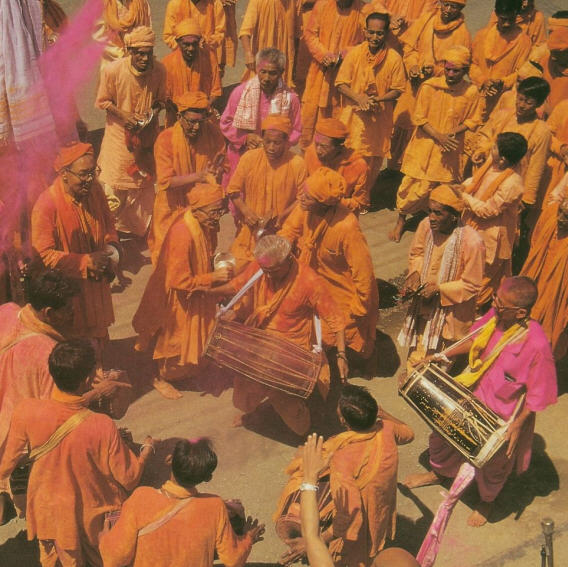
A drought is on. This is mid March, supposedly a season of rain showers, but the last rain was in February, and that gave only a little. But, drought aside, today is the second day of the festivities for Holi.
A group of devotees meet us and festoon us with fluffy garlands of cotton thread bright red, white, green, yellow, with some silvery tinsel mixed in. Then we're into a jeep, some cars, and Maruti vans, and on our way to our temple.
We get down a few blocks early: We're in for a big reception. Awaiting us, lining the road, stand rows and rows of men and women, dressed in garments of bright Holi colors solid red and pink-scarlet with drums, cymbals, double conches. The faces are Chinese-Tibetan, and the chanting is Hare Krsna, loud and strong, in a unique Manipuri style.
People pour big pots of water on our feet and toss handfuls of flaked rice into the air an auspicious greeting. In the midst of it all, Manipuri faces behind video cameras get it all on tape. (Sony has made it to Manipur.)
Ceremonies in the temple, some refreshments, some rest, and we're off for sankirtana at the temple of Govindaji. The Deity of Govindaji is the ultimate object of love and devotion for people throughout Manipur, and today people have come to see Him and celebrate Him from all over the state.
In the courtyard of the temple, crowds arrive in parties of sankirtana drummers, cymbal players, conch blowers, banner carriers singing the glories of Govindaji.
The mood is joyful, and part of the fun is the traditional Holi spraying of colors water dyed red or pink or purple, sucked up from vats and shot up into the air and onto the crowds from brass syringes the size of rifles. Everyone sprays and gets sprayed, so your clothes and face and arms and all of you gets thoroughly parti-colored. The fun goes on well into the night.
The next morning things have calmed down, the dye (less tenacious than in Calcutta) has mostly washed off your skin, and we're off to Moirang, about thirty miles south. Along the way, bands of young girls at intervals barricade the road with rope or bamboo, demanding a rupee to let your car pass. In Manipur that's another Holi tradition. Everyone gives.
In Manipur the Holi celebrations go on for six days. The markets close, and sankirtana parties travel from place to place, chanting the holy names of the Lord Hare Krsna, Hare Krsna, Krsna Krsna, Hare Hare/ Hare Rama, Hare Rama, Rama Rama, Hare Hare.
On our way to Moirang, we stop at several towns along the road. At each stop, arrangements have been made for us to witness a performance of sankirtana. Sankirtana in Manipur is a highly cultivated art. Professional and semi-professional groups perform at birth ceremonies, weddings, festivals, and other such occasions. Usually, several groups perform at every function.
A typical performance takes place at Bishnupur, a fair-sized town (signs on shops: "Vishnu Pharmacy," "Sanjit Video Parlor"). To start the sankirtana, the first group shouts out, "Gauranga Mahaprabhu ki jaya!" ("All glories to Lord Caitanya Mahaprabhu.") Then the drumming begins.
This is power drumming, with five or seven pungs (Manipuri mrdanga drums). Complex rhythms swirl into one another, punctuated by cymbals played with equal finesse. And the drummers dance with acrobatic virtuosity, tightly choreographed. The drummers play and dance with a look of serious, determined intensity, We're reminded that Manipur has been a kingdom of ksatriyas, royal warriors, people you don't want to mess with.
The drumming leads into the singing, songs glorifying the Lord. The melodies are attuned to the seasons. The melodies now are those of spring.
Groups take their turns drumming, dancing, and singing, groups of boys, of men, and of women also, the women dressed traditionally in lotus pink.
As each performance ends, the singers and dancers offer obeisances, and at the end of it all, prasadam is distributed tangerines and apples and then we're back on the road.
At Moirang we have another ISKCON temple and asrama. There, more sankirtana performances and then lunch prasadam. In Manipur the preparation, offering, and distribution of prasadam are also highly cultivated arts. The devotees offer Krsna many delicious varieties of food, made from what's locally in season. The spicing is sometimes mild, sometimes fiery. Among the special items: vegetables and salads made with the roots of lotuses.
The plates themselves are made of banana leaves or lotus leaves, with the various items of food placed in boat-shaped cups, again fashioned from leaves of banana or lotus.
For the next several days, in the afternoons and early evenings we visit friends and ISKCON members at their homes. There we perform our own sankirtana and speak a little bit about Krsna. This too is part of the Manipuri Holi tradition: sankirtanagroups go from home to home, chanting the glories of the Lord.
One ISKCON member whose home we visit is Sri Radhabinod Koijam, the deputy chief minister of Manipur. We chant in his courtyard, and afterwards he gives a few words of thanks: "By your visit, by your presence, our state is blessed, and my home is blessed today. By chanting the names of Lord Caitanya and Lord Krsna we are convinced we can have peace, and we can relieve any problems affecting the state."
Problems there are. Local political movements are in tension with the Indian central government. And the traditional culture of Manipur is in tension with the outside world.
We saw this graphically the last night we were there. As part of a cultural program, an ensemble of tribal people put on a demonstration of their traditional folk dances. Colorful and lively, this was a fairly slick performance by hill people now accustomed to city life in Imphal.
What wasn't expected, though, was their last number, "The Fashion Show." For this one, the flutes, gongs, and bass drums gave way to a tape of 1950's American top 40. The young men and women who in the previous hour, dressed in blue and red indigenous costumes, had regaled us with such items as their harvest dance now lined up in Western-cut suits and satiny dresses and high heels and, one at a time, came forward to sensuously pose and posture in a perfectly serious and perfectly incongruous mimicry of what the world expects from Paris.
Defenders of Manipur, you have your task before you!
Visting Manipur
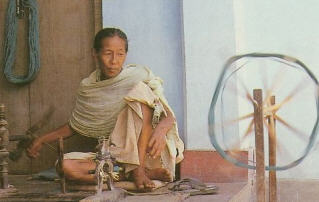
To visit Manipur, non-Indians need a special permit. Because of political disturbances in the northeastern states of India, requests for such permits are not easily granted. When granted, the permits allow one to stay for five days.
Indian Airlines runs flights daily between Imphal and Calcutta and several times a week between Imphal and New Delhi. Sahara Airlines flies Imphal-New Delhi twice a week.
Manipur: The land at a glance
Area: 8,632 square miles (roughly the size of the American state of Massachusetts).
Geography: The land is hilly, rugged, and generously watered. The Manipur valley (about 700 square miles) lies 2,600 feet above sea level. The hills to the north rise to more than 8,000 feet. Eighty to ninety percent of the land is forested.
Climate: The summers are warm and rainy, the winters cool and dry. Temperatures run from 38 degrees F in January to 82 degrees in July and August.
Population: 1,826,714 (latest census: 1991)
People per square mile: 212
Main language: Manipuri
Literacy rate: 41.35 percent
Religion: Gaudiya Vaisnava 62%, Christian 26% (mainly among the tribal people of the hills), Muslim 8%. The remaining 4% mainly follow various ancestral traditions.
Main occupations: agriculture, weaving
Main crops: rice, corn, sugarcane, oil seeds, fruits, vegetables.
Main manufactured goods: lumber, sugar, and handicrafts.
Capital: Imphal (population 130,000). Manipur has seven other small cities and some 2,000 agricultural villages.
Favorite sport: polo (Manipur is where it started, and where the British learned it).
Political history: Manipur was an independent kingdom until 1891, when it was conquered by the British in the Anglo-Manipuri war. Manipur regained independence, with the rest of India, in 1947. It merged into India in 1949, first as a centrally administered territory and later, since 1972, as a full-fledged Indian state.
How Manipur Became a Krsna Conscious State
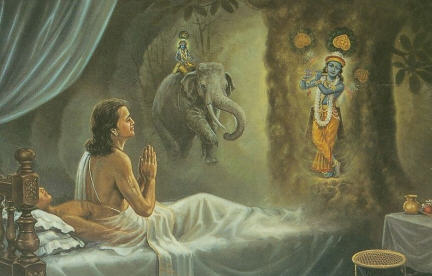
The Vedic scriptures tell us that Manipur was a Krsna conscious land even more than five thousand years ago. But for the last several centuries the Manipuris have also worshiped various regional semi-historical deities, who hold a place in Manipuri culture even today.
In modern times, worship of Visnu first gained prominence in Manipur in the fifteenth century, during the reign of King Kyamba. It is said that the Pong king Khekhombha fo the Shan kingdom* gave Kyamba a Visnu cakra (the symbolic disc of Visnu). The presence of the cakra seemed to bring about various supernatural events, so on the advice of brahmanas the king had a temple constructed for it and instituted regular worship. The worship was continued by his descendants.
*A tract of land between Assam and Burma, annexed to Burma in 1752.
The philosophy taught by Lord Caitanya Mahaprabhu was first introduced in the seventeenth century by five disciples of the great devotee Srila Narottama Dasa Thakura. The songs of Srila Narottama Dasa Thakura are still sung throughout Manipur, and his birthday is an occasion of festivities.
In the early eighteenth century, the powerful king Garibniwaj embraced the worship of the Personality of Godhead in the form of Lord Ramacandra. But the wave of devotion that turned the entire kingdom Krsna conscious took place during the reign of Garibniwaj's grandson Rajarsi Bhagyacandra.
The Victory of King Bhagyacandra
Bhagyacandra ascended the throne in 1759, but in 1762 the Burmese, acting in concert with his envious maternal uncle, invaded Manipur, and the king, with his queen and a few attendants, fled to the neighboring state of Ahom, now known as Assam.
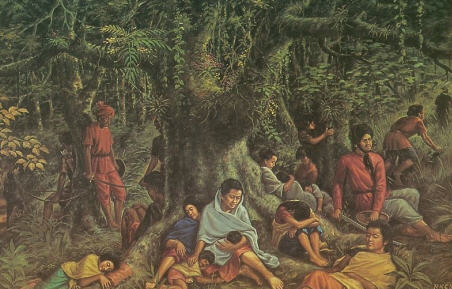
The King of Ahom, King Rajesvara, had heard of Bhagyacandra's virtues and was pleased to receive him. They became close friends, and Rajesvara arranged for Bhagyacandra to stay in the vicinity of the royal palace.
But Bhagyacandra's crafty uncle wrote a letter to the king saying that the person taking refuge at his court was an imposter, not the great Bhagyacandra. The uncle advised the king of Ahom to destroy him.
The message seems to have influenced King Rajesvara. Though not entirely persuaded, he began treating Bhagyacandra with coolness and suspicion.
The real Bhagyacandra was said to have supernatural powers. So finally, on the advice of senior ministers, King Rajesvara reluctantly devised a test: In a public arena, Bhagyacandra, unarmed, was to catch and tame a wild elephant.
Confronted with this humanly impossible task, King Bhagyacandra prayed to Lord Krsna for guidance. Lord Krsna then appeared to him in a dream and advised him to enter the arena with a garland and japa beads in hand. Victory, Lord Krsna told him, was assured.
In the future, the Lord said, Bhagyacandra would be the sole king of Manipur. Upon regaining the kingdom, he should install a Krsna Deity, The Deity, Govindaji, should be carved from a certain old jackfruit tree growing on the slopes of a hill known as Kaina, and the physical features of the Deity should match those the king was seeing now.
After installing the Deity, the Lord said, the king should arrange for the performance of a rasa-lila, in which the Deity should be worshiped with songs and dances. The Lord enabled Bhagyacandra to envision in detail the kinds of dress the dancers should wear and the manner in which the songs and dances should be composed.
The next morning, crowds waited on rooftops and treetops to see the fate of the supposed king of Manipur. Bhagyacandra solemnly entered the arena, holding the garland and japa beads and chanting the holy name of Lord Krsna.
The elephant charged from a distance, but as it neared Bhagyacandra it slowed down and then knelt before him. According to some accounts, the elephant seemed as though struck repeatedly by some unseen enemy. King Bhagyacandra alone, we are told, could see Lord Krsna sitting atop the elephant's head like a mahout. And to that Lord the king offered the garland from his hand. The king then mounted the elephant and rode triumphantly through the cheering crowds.
Thoroughly convinced, King Rajesvara profusely apologized and offered his full assistance. He supplied men and arms to help King Bhagyacandra win back his kingdom.
After an arduous trek from Ahom through the jungles, Bhagyacandra returned with his forces to Manipur and regained the throne. He restored the kingdom to normalcy and set about to consolidate its small kingdoms into one state, while still preserving cultural diversity.
Lord Govindaji Appears Again
For some reason, some say because of repeated Burmese invasions, Bhagyacandra did not at once install the Deity of Govindaji. But one day a tribal woman appeared at the gates of his palace, insisting on having an audience with the king. She bore a message, she said, from someone even higher than him.
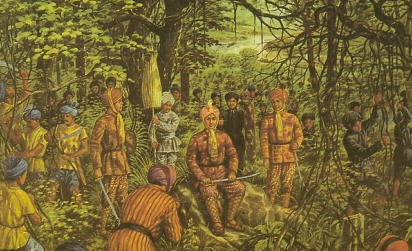
Granted a private audience, the woman told the king that while she was cultivating vegetables in her field a young boy came before her and began playing tricks. He won the woman's affection and asked her to convey to the king a message: He had made a promise, but now he was neglecting it, and the boy was very angry.
The king at once understood that the boy was Krsna Himself. He returned with her to her village on the slope of Kaina and there found the old jackfruit tree of which Lord Krsna had spoken.
The king arranged to fell the great tree, had it brought back to his capital, Langthabal, and appointed expert sculptors to carve the Deity. He described to the sculptors precisely how the Lord should look, according to the vision he had seen, and advised them also to consult the descriptions in Srimad-Bhagavatam.
The sculptors carved a beautiful image, and when the king saw it he acknowledged that the form was superb. But it did not, he said, match his vision. By the king's order, the Deity was named Sri Vijaya Govindaji and opulently installed. An elderly uncle of the king became the priest of the Deity. The king then ordered the sculptors to carve another.
They began again, but again the Deity differed from the form the king had envisioned. This happened several times. Each time, the king had the Deity opulently installed in a different temple and told the sculptors to try again.
The sculptors were getting anxious not much was left of the tree but at last they carved a Deity that the king said matched his vision precisely.
With joyous festivities the Deity was installed, and from the very beginning He was revered as the Supreme Personality of Godhead. The king himself, his court, his entire state all were dedicated to Govindaji.
Skillfully, the king introduced all the features of traditional worship of Lord Krsna as taught by the followers of Lord Caitanya. Rather than try to stamp out previous traditions of Manipuri religion and culture, by his own example he inspired his people in devotional service to Govindaji.
Devotion to Govindaji became the focus of the spiritual and cultural life of Manipur. The people became Vaisnavas, devotees of Krsna, but they expressed their devotion with a special Manipuri spirit. They were Manipuri Vaisnavas, and they are still known as such till this day.
The First Rasa-Lila
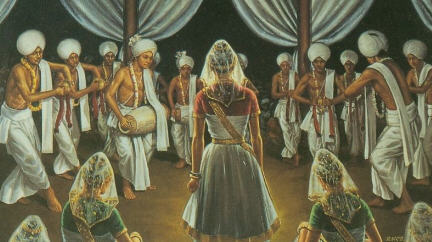
After the installation of Govindaji, yet to be fulfilled was Krsna's order that the king arrange for the performance of rasa-lila. The king now set about this in earnest. He engaged various experts to compose the music, design the costumes, conceive the dances, and so on. In all matters, the king himself gave guidance.
The dance was not to be merely an artistic performance. Rather, the dance was to be done for the pleasure of the Deity and the spiritual upliftment of the audience. Krsna's pastimes take place on the highest level of spiritual devotion, and the performance had to convey the pastimes of the Lord in all their purity. Grace, delicacy, chastity, and deep spiritual feeling all these were to be hallmarks of the rasa-lila.
The rasa-lila was to be performed not in a theater but in a "rasa-mandala" specially constructed for the Deity, Lord Govindaji. Govindaji Himself would be in the center of the rasa-lila.
But as yet there was no Deity of the Lord's consort, Srimati Radharani. Who then would play her role? For the pleasure of Lord Govindaji, the king selected his own daughter, the young and beautiful princess Bimbavati. And the king himself became one of the mrdanga drummers for the satisfaction of the Lord.
The rasa-lila was held in November 1779, on the night of the full moon. By all accounts it was splendidly performed. Over the years, the rendering of rasa-lila through dance and song developed into a highly refined art, and till this day it is celebrated as a sacred tradition in Manipur. And whenever it is performed, a prayer is made to Govindaji on behalf of Maharaja Bhagyacandra.
Perfecting a Life of Devotion
Princess Bimbavati herself was so overcome with devotion that she renounced the world and spent the rest of her life serving Lord Krsna and singing His holy names. She became famous as Sija Lairoibi, meaning "the princess who owned the Lord." The golden deity of Radharani at the Govindaji temple was later made in her likeness.
After ruling for 39 years, till 1798, King Bhagyacandra decided to retire from political life. With his sons, several queens, and several hundred associates, he left the kingdom for what in those days was a most difficult journey a pilgrimage on foot to the Ganges at Murshidabad, in what is now West Bengal.
The king handed over the state of Manipur to his eldest son, Labanyacandra, and spent the rest of his days in a life of detachment and devotion. He passed away in October of 1799 at Murshidabad. There his body was cremated, near the tomb of the great Srila Narottama Dasa Thakura, of whom many devotees in those times believed him an incarnation. The brahmanas of those days gave him the title "Rajarsi," meaning a sage in the form of a king.
By the king's will, a portion of his ashes was brought back to Manipur and buried at the royal cremation ground, and another portion was brought to Navadvipa, the abode of Sri Caitanya Mahaprabhu.
Rajkumar Chandrajit Sana, popularly known as RKCS, is a leading artist of Manipur. The paintings shown here come from his series of seventy-two canvases depicting the history of Manipur from 1709 through 1949.
NOTE: For information used in this article I am indebted to R. K. Gopal Singh and Dr. N. Tombi Singh, author of Manipur and the Mainstream.
"The Land of Jewels"
Legends describe that millions of years ago Lord Siva and his consort Parvati danced together in Manipur while the many-hooded divine serpent Ananta Sesa illuminated the dance arena with the jewels from his crowns. Enchanted by the celestial music that accompanied the dance, Ananta Sesa swayed back and forth, unaware that the jewels from his splendid crowns were falling upon the earth. The beautiful site of this pastime became known as Manipur, "the land of jewels."
The Mahabharata mentions that in the kingdom of Manipur, more than five thousand years ago, the prince Arjuna married the Manipuri princess Citrangada. Their son Babhruvahana ruled Manipur for a very long time. Though some scholars (of course) disagree, most scholars and adherents of the Vedic tradition identify that kingdom of Manipur with the present Manipur state.
Manipuri Names
We're used to seeing surnames last, but in Manipur the surname comes first. The last name is an indication of caste, usually Sharma for brahmanas and Singh for all others (mostly ksatriyas). One's given name is the name in the middle. The prefix Raj Kumar or Raj Kumari is used by descendants of the royal family. So, for example, in the name Chingangbam Budha Singh, Chingangbam is the family name, and the given name is Budha.
Manipuri Holy Places Outside Manipur
Because the Manipuri Vaisnavas are devotees of Lord Sri Krsna and Lord Sri Caitanya Mahaprabhu, they have established many temples in Navadvipa, Vrndavana, and Radha-kunda. Non-Indians unable to visit Manipur can more easily visit these temples.
Navadvipa: Navadvipa has several Manipuri temples, clustered together along the Ganges, across the road from the Devananda Gaudiya Math.
The Anu Mahaprabhu Mandir. Like her father, Rajarsi Candrabhagya, Princess Bimbavati left Manipur on pilgrimage to the Ganges at Navadvipa. There a temple was raised, in which the Deity installed was carved from the same jackfruit tree as the Govindaji Deity in Manipur. Bimbavati lived here till she expired. The temple is now being nicely maintained by six brothers descending from the royal family.
Sri Gopalaji Mandir. Also known as Manipuri Raj Bari ("Bari" is Bengali for "home"). Built by Maharaja Sri Churachand Singh (knighted by the British), who was king from 1891 through 1941. The temple is now under the care of a trust, of which Bhakti Svarupa Damodara Swami is the chairman.
Sri Sri Radha-Krsnacandra Mandir. Temple built by Maharani Dhan Manjari, the wife of Churachand Maharaja. Later in life, the king and his wife were not getting along together so well, so they had different temples. Hers is over the wall from Gopalaji.
Vrndavana: In Vrndavana, five or six small temples are to be found in the area of Kesi Ghata. The temples are about 80 or 100 years old. Most prominently, there is the Manipuri Raj Bari, built by Maharaja Dumbra Singh. (To find them, ask anyone for the "Manipuri temples.")
Radha-kunda: More Manipuris live in Radha-kunda than in Vrndavana itself. The Manipuri royal family has shown great devotion for Radha-kunda. The present paving around Radha-kunda and Syama-kunda was done by Maharaja Churacand. Radha-kunda has twenty-seven Manipuri temples, most built by the royal family. Among the temples, two are the most prominent.
Sri Gopalaji Mandir. Built eighty years ago by Maharaja Curacanda. The temple is designed so that in autumn the rising sun shines directly on the Deity. The temple is now under the care of Bhakti Svarupa Damodara Swami.
Baro Gunja. This temple, still larger, was also built by the King Gambhira Singh. Installed here is a beautiful Deity of Radha-Krsna. The temple is notable for its attractive architecture.
Elsewhere: Jagannatha Puri. By the western side of the Jagannatha temple is a Manipuri dharmasala for pilgrims, again built by the royal families.
Near Manipur. Manipuris have built temples in the northeastern Indian states near Manipur, such as Assam, Tripura, and Meghalaya. The ISKCON temple in Agartala, the capital of Tripura, was a gift of a descendant of the Manipuri royal family, Sri R.K. Kamaljit Singh. Manipuris living in Agartala have also built temples in Radha-kunda, Vrndavana and Navadvipa.
Large communities of Manipuris live in the Sylhet district of Bangladesh and the Mandalay district of Myanmar (formerly Burma). Manipuri devotees have built temples in both places.
Srila Prabhupada on Manipur:
"A Wonderful Place"
In the Srimad-Bhagavatam (9.22.32) it is said, sutayam babhruvahanam manipura-pateh so 'pi tat-putrah putrika-sutah: "By his wife the princess of Manipur, Arjuna had a son named Babhruvahana, who became the adopted son of the Manipuri king."
Srila Prabhupada gives the following purport:
"It is to be understood that Parvati [the wife of Lord Siva] is the daughter of the king of the very, very old mountainous country known as the Manipur state. Five thousand years ago, therefore, when the Pandavas ruled, Manipur existed, as did its king. Therefore this kingdom is a very old, aristocratic Vaisnava kingdom. If this kingdom is organized as a Vaisnava state, this revitalization will be a great success because for five thousand years this state has maintained its identity. If the Vaisnava spirit is revived there, it will be a wonderful place, renowned throughout the entire world. Manipuri Vaisnavas are very famous in Vaisnava society. In Vrndavana and Navadvipa there are many temples constructed by the king of Manipur. Some of our devotees belong to the Manipur state. The Krsna consciousness movement, therefore, can be well spread in the state of Manipur by the cooperative efforts of the Krsna conscious devotees."
